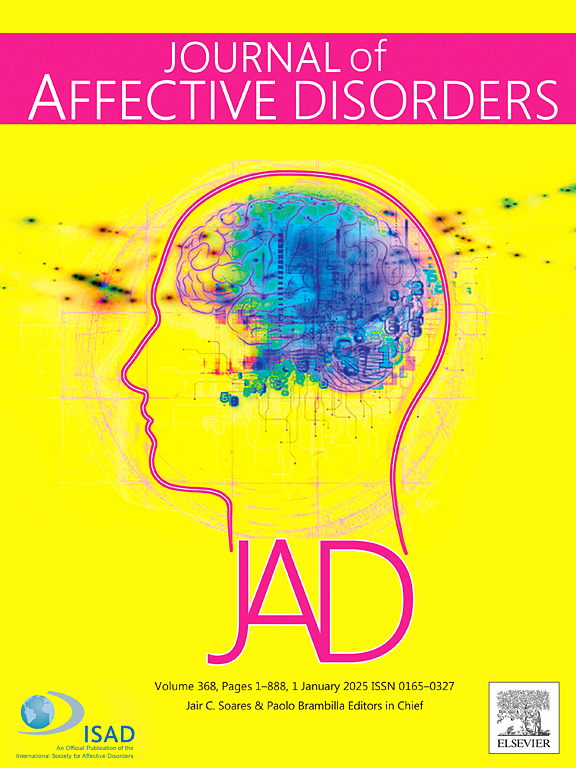Hospital admissions for anxiety disorder, depression, and bipolar disorder and venous thromboembolism: A UK biobank prospective cohort study
IF 4.9
2区 医学
Q1 CLINICAL NEUROLOGY
引用次数: 0
Abstract
Background
Few studies have investigated whether and which anxiety and affective disorders are associated with the risk of venous thromboembolism. We aimed to examine whether anxiety disorder, depression, and bipolar disorder increase the risk of venous thromboembolism, independent of socioeconomic confounders and each other, in a UK general population.
Methods
This is a prospective cohort study using UK Biobank. Participants were excluded if they were diagnosed with venous thromboembolism before the baseline assessment, if they were first diagnosed with anxiety disorder, depression, or bipolar disorder thereafter, or if they had missing sociodemographic data. Diagnosed anxiety disorder, depression, and bipolar disorder were ascertained through hospital admission data and incident venous thromboembolism, pulmonary embolism, and deep vein embolism were ascertained through both hospital admission and death certificate data. Hazard ratios were calculated, adjusted for sociodemographic confounders and comorbid anxiety and affective disorders.
Results
Our main analysis included 455,705 participants, of whom 53.6 % were female, with a mean age (standard deviation) of 56.6 (8.1) years. Anxiety disorder, depression, and bipolar disorder were associated with venous thromboembolism both before and after adjusting for sociodemographic confounders. After adjustment for comorbid anxiety and affective disorders, depression (HR: 2.00; 95 % CI: 1.68–2.38) and bipolar disorder (HR: 2.08; 95 % CI: 1.28–3.37) remained associated with venous thromboembolism, but anxiety did not (HR: 1.17; 95 % CI: 0.88–1.57). Similar results were found for pulmonary embolism and deep vein embolism.
Conclusions
Depression and bipolar disorder were associated with the risk of venous thromboembolism. Further research is required to understand the mechanism underlying their increased risk.
住院焦虑症、抑郁症、双相情感障碍和静脉血栓栓塞:英国生物库前瞻性队列研究
背景:很少有研究调查焦虑和情感性障碍是否以及哪些与静脉血栓栓塞的风险相关。我们的目的是研究在英国普通人群中,焦虑障碍、抑郁和双相情感障碍是否会增加静脉血栓栓塞的风险,独立于社会经济混杂因素和彼此。方法:这是一项使用英国生物银行的前瞻性队列研究。如果参与者在基线评估前被诊断为静脉血栓栓塞,如果他们之后首次被诊断为焦虑症、抑郁症或双相情感障碍,或者如果他们缺少社会人口统计数据,则将被排除在外。通过住院资料确定诊断为焦虑症、抑郁症和双相情感障碍,通过住院和死亡证明资料确定静脉血栓栓塞、肺栓塞和深静脉栓塞的发生率。计算风险比,并根据社会人口学混杂因素、共病焦虑和情感障碍进行调整。结果:我们的主要分析包括455,705名参与者,其中53.6 %为女性,平均年龄(标准差)为56.6(8.1)岁。焦虑障碍、抑郁和双相情感障碍在调整社会人口混杂因素之前和之后都与静脉血栓栓塞相关。调整共病焦虑和情感性障碍后,抑郁(HR: 2.00;95 % CI: 1.68-2.38)和双相情感障碍(HR: 2.08;95 % CI: 1.28-3.37)仍与静脉血栓栓塞相关,但焦虑与静脉血栓栓塞无关(HR: 1.17;95 % ci: 0.88-1.57)。肺动脉栓塞和深静脉栓塞的结果相似。结论:抑郁症和双相情感障碍与静脉血栓栓塞的风险相关。需要进一步的研究来了解风险增加背后的机制。
本文章由计算机程序翻译,如有差异,请以英文原文为准。
求助全文
约1分钟内获得全文
求助全文
来源期刊

Journal of affective disorders
医学-精神病学
CiteScore
10.90
自引率
6.10%
发文量
1319
审稿时长
9.3 weeks
期刊介绍:
The Journal of Affective Disorders publishes papers concerned with affective disorders in the widest sense: depression, mania, mood spectrum, emotions and personality, anxiety and stress. It is interdisciplinary and aims to bring together different approaches for a diverse readership. Top quality papers will be accepted dealing with any aspect of affective disorders, including neuroimaging, cognitive neurosciences, genetics, molecular biology, experimental and clinical neurosciences, pharmacology, neuroimmunoendocrinology, intervention and treatment trials.
 求助内容:
求助内容: 应助结果提醒方式:
应助结果提醒方式:


